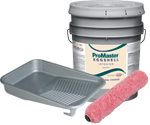Low Volatile Organic Compounds (VOC) Paints
Volatile organic compounds (VOC) are harmful chemicals found in paint and various other products. According to the United States Environmental Protection Agency (EPA), when airborne, these chemicals can cause respiratory and other serious health problems as well as air pollution. In fact, paint is the second largest source of VOC emissions just behind cars. Avoid unnecessary exposure to these harmful chemicals by using low VOC paints. Low VOC paints are eco-friendly paints and safer to use than conventional paint.
Avoid Toxic Fumes
Paint fumes are toxic. Choosing paints that are low VOC means your paint is safer—not only for the environment, but also for the people who work and breathe around painting projects. Inhaling paint fumes can cause irritation in the nose, eyes, and throat, or more serious issues like shortness of breath and respiratory issues. Exposure to VOCs has even been linked to cancer, so choosing a low VOC paint to improve the indoor air quality is extremely important.
In addition to using low VOC paints, use the correct personal protective equipment when painting, including any appropriate respiratory protection and safety eyewear. Remember to have proper ventilation and portable fans as needed.
Low VOC Paint Quality
How do low VOC paints compare to the traditional, more odorous paints? Low VOC paints are affordable, cover just as well, and are as durable as other paints. For facilities such as hospitals and schools, where good air quality is vital, low VOC paints are a must. All of our interior/exterior architectural paints are low VOC and we also offer low VOC spray paint.
Paint Disposal and Recycling
Another way paint can cause harm to people and the environment is by improper disposal. Unused paint should be properly recycled or disposed of to protect the environment and the population. Many cities offer paint collection centers that will recycle leftover paint. If recycling is not an option, add paint hardener to dry up left over paint. Hardened paint is much safer to dispose of and will prevent a toxic spill on your property.






